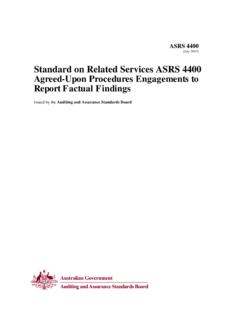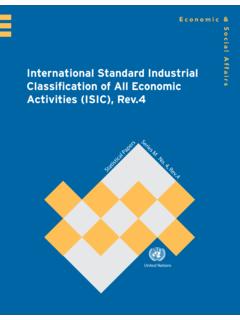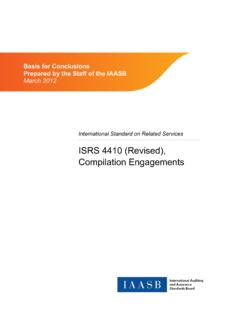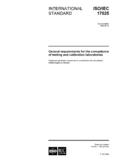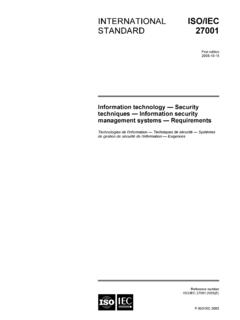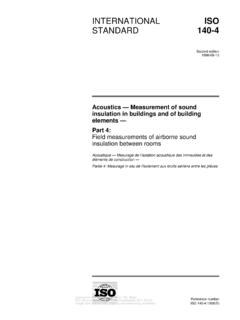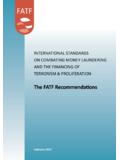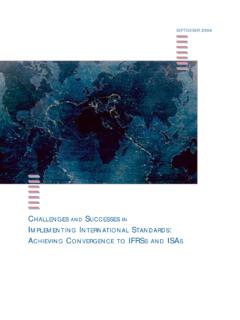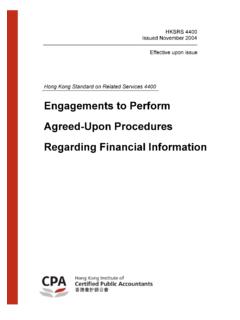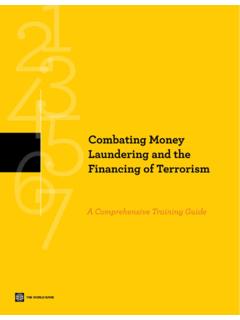Transcription of Social Accountability 8000 - IQNet Association
1 Social Accountability 8000 international Standard by Social Accountability international June 2014 SA8000 : 2014 Supersedes previous versions: 2001, 2004 and 2008 The official language of this Standard and supporting documents is English. In the case of inconsistency between versions, reference shall default to the English version. 1 SA8000 is a registered trademark of Social Accountability international SA8000: 2014 international Standard About the Standard This is the fourth issue of SA8000, a voluntary standard for auditable third-party verification, setting out the requirements to be met by organisations, including the establishment or improvement of workers rights, workplace conditions and an effective management system. However, certification is only available per specific worksite. The foundational elements of this Standard are based on the UN Declaration of Human Rights, conventions of the ILO, international human rights norms and national labour laws.
2 The normative SA8000 certification audit reference documents are the SA8000: 2014 Standard and the SA8000 Performance Indicator Annex. Additionally, the SA8000 Guidance Document facilitates compliance with the Standard. The SA8000 Performance Indicator Annex, a normative document, sets out the minimum performance expectations of an SA8000 certified organisation. The Performance Indicator Annex is found online at the SAI website. The SA8000 Guidance Document provides interpretations of SA8000 and how to implement its requirements; provides examples of methods for verifying compliance; and serves as a handbook for auditors and for organisations seeking SA8000 certification. The Guidance Document is found online at the SAI website. Although SA8000 is universally applicable, and certification is in principle available in any state or industry, there are exceptions to SA8000 certification.
3 The SAI Advisory Board considers that there are some sectors where meeting all Standard requirements poses special difficulty due to industry norms and technical needs. The list of these current exceptions is found online at the SAI website. SA8000 is revised periodically as conditions change. Its revisions also incorporate corrections and improvements received from interested parties. It is hoped that the Standard, its Performance Indicator Annex and its Guidance Document will continue to improve, with the help of a wide variety of participants. SAI welcomes your suggestions as well. To comment on SA8000, the SA8000 Performance Indicator Annex or the SA8000 Guidance Document, please send written remarks to SAI at the physical or email address indicated below. SAI Social Accountability international SAI 2014 THE SA8000 STANDARD MAY BE REPRODUCED ONLY IF PRIOR WRITTEN PERMISSION FROM SAI IS OBTAINED. SAI 15 West 44th Street 6th Floor New York, NY 10036 USA +1-212-684-1414 +1-212-684-1515 (facsimile) e-mail: SA8000: 2014 international Standard Contents I.
4 INTRODUCTION 1. Management System 2. Intent and Scope II. NORMATIVE ELEMENTS AND THEIR INTERPRETATION III. DEFINITIONS 1. Shall 2. May 3. Child 4. Child labour 5. Collective bargaining agreement 6. Corrective action 7. Preventive action 8. Forced or compulsory labour 9. Home worker 10. Human trafficking 11. Interested parties 12. Living wage 13. Non-conformance 14. Organisation 15. Personnel 16. Worker 17. Private employment agency 18. Remediation of child labourers 19. Risk assessment 20. SA8000 worker representative(s) 21. Social performance 22. Stakeholder engagement 23. Supplier/subcontractor 24. Sub-supplier 25. Worker organisation 26. Young worker IV. Social Accountability REQUIREMENTS 1. Child Labour 2. Forced or Compulsory Labour 3. Health and Safety 4. Freedom of Association & Right to Collective Bargaining 5. Discrimination 6. Disciplinary Practices 7. Working Hours 8. Remuneration 9. Management System SA8000: 2014 international Standard I. Introduction 1.
5 INTENT AND SCOPE Intent: The intent of SA8000 is to provide an auditable, voluntary standard, based on the UN Declaration of Human Rights, ILO and other international human rights and labour norms and national labour laws, to empower and protect all personnel within an organisation s control and influence who provide products or services for that organisation, including personnel employed by the organisation itself and by its suppliers, sub-contractors, sub-suppliers and home workers. It is intended that an organisation shall comply with this Standard through an appropriate and effective Management System. Scope: It is universally applicable to every type of organisation, regardless of , its size, geographic location or industry sector. 2. Management System Throughout your review of the next eight elements of SA8000, the requirements of this element - Management System - are central to their correct implementation, monitoring and enforcement. The Management System is the operational map that allows the organisation to achieve full and sustained compliance with SA8000 while continually improving, which is also known as Social Performance.
6 When implementing the Management System element, it is a required priority that joint worker and management involvement be established, incorporated and maintained throughout the compliance process with all the Standard s elements. This is particularly critical to identify and correct non-conformances and to assure continuing conformance. SA8000: 2014 international Standard II. Normative Elements and Their Interpretation The organisation shall comply with local, national and all other applicable laws, prevailing industry standards , other requirements to which the organisation subscribes and this Standard. When such laws, standards or other requirements to which the organisation subscribes and this Standard address the same issue, the provision most favourable to workers shall apply. The organisation shall also respect the principles of the following international instruments: ILO Convention 1 (Hours of Work Industry) and Recommendation 116 (Reduction of Hours of Work) ILO Conventions 29 (Forced Labour) and 105 (Abolition of Forced Labour) ILO Convention 87 (Freedom of Association ) ILO Convention 98 (Right to Organise and Collective Bargaining) ILO Conventions 100 (Equal Remuneration) and 111 (Discrimination Employment and Occupation) ILO Convention 102 ( Social Security - Minimum standards ) ILO Convention 131 (Minimum Wage Fixing) ILO Convention 135 (Workers Representatives) ILO Convention 138 and Recommendation 146 (Minimum Age) ILO Convention 155 and Recommendation 164 (Occupational Safety and Health) ILO Convention 159 (Vocational Rehabilitation and Employment - Disabled Persons) ILO Convention 169 (Indigenous and Tribal Peoples) ILO Convention 177 (Home Work) ILO Convention 181 (Private Employment Agencies) ILO Convention 182 (Worst Forms of Child Labour) ILO Convention 183 (Maternity Protection)
7 ILO Code of Practice on HIV/AIDS and the World of Work Universal Declaration of Human Rights The international Covenant on Economic, Social and Cultural Rights The international Covenant on Civil and Political Rights The United Nations Convention on the Rights of the Child The United Nations Convention on the Elimination of All Forms of Discrimination Against Women The United Nations Convention on the Elimination of All Forms of Racial Discrimination UN Guiding Principles on Business and Human Rights SA8000: 2014 international Standard III. Definitions (organized either alphabetically or by logical flow) 1. Shall: In this Standard the term shall indicates a requirement. Note: Italics have been added for emphasis. 2. May: In this Standard the term may indicates a permission. Note: Italics have been added for emphasis. 3. Child: Any person under 15 years of age, unless the minimum age for work or mandatory schooling is higher by local law, in which case the stipulated higher age applies in that locality.
8 4. Child labour: Any work performed by a child younger than the age(s) specified in the above definition of a child, except as provided for by ILO Recommendation 146. 5. Collective bargaining agreement: A contract specifying the terms and conditions for work, negotiated between an organisation ( employer) or group of employers and one or more worker organisation(s). 6. Corrective action: Action to eliminate the cause(s) and root cause(s) of a detected non-conformance. Note: Corrective action is taken to prevent recurrence. 7. Preventive action: Action to eliminate the cause(s) and root cause(s) of a potential non-conformance. Note: Preventive action is taken to prevent occurrence. 8. Forced or compulsory labour: All work or service that a person has not offered to do voluntarily and is made to do under the threat of punishment or retaliation or that is demanded as a means of repayment of debt. 9. Home worker: A person who is contracted by the organisation or by its supplier, sub-supplier or subcontractor, but does not work on their premises.
9 10. Human trafficking: The recruitment, transfer, harbouring or receipt of persons, by means of the use of threat, force, deception or other forms of coercion, for the purpose of exploitation. 11. Interested parties: An individual or group concerned with or affected by the Social performance and/or activities of the organisation. 12. Living Wage: The remuneration received for a standard work week by a worker in a particular place sufficient to afford a decent standard of living for the worker and her or his family. Elements of a decent standard of living include food, water, housing, education, health care, transport, clothing, and other essential needs including provision for unexpected events. 13. Non-conformance: Non-compliance with a requirement. 14. Organisation: The entirety of any business or non-business entity responsible for implementing the requirements of this Standard, including all personnel employed by the organisation. Note: For example, organisations include: companies, corporations, farms, plantations, cooperatives, NGOs and government institutions.
10 15. Personnel: All individuals employed or contracted by an organisation, including but not limited to directors, executives, managers, supervisors, workers and contract workers such as security guards, canteen workers, dormitory workers and cleaning workers. 16. Worker: All non-management personnel. 17. Private employment agency: Any entity, independent of the public authorities, which provides one or more of the following labour market services: SA8000: 2014 international Standard Matching offers of and applications for employment, without the agency becoming a party to the employment relationship(s) which may occur; Employing workers with a view to making them available to a third party entity, which assigns their tasks and supervises the execution of these tasks. 18. Remediation of child labourers: All support and actions necessary to ensure the safety, health, education and development of children who have been subjected to child labour, as defined above, and whose work has been terminated.

